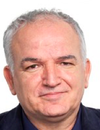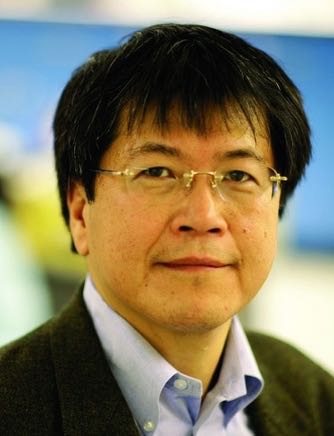Monday, 2 October 201712:45 | Conference Registration, Materials Pick-Up, and Networking | |
Session Title: Opening Plenary Session -- Convergence of Microfluidics, POC Diagnostics and Biosensors |
| | 13:30 |  | Keynote Presentation Micro & Nanotechnologies For Physical Phenotyping of Cells
Dino Di Carlo, Armond and Elena Hairapetian Chair in Engineering and Medicine, Professor and Vice Chair of Bioengineering, University of California-Los Angeles, United States of America
My lab uses microtechnology to interface at the scale of biology to aid
in scientific investigation, develop new approaches to diagnose and
monitor disease, and engineer therapies. A part of our laboratory
develops tools to assay and exploit physical properties of cells in
diagnostics and drug screening. Physical properties of cells can provide
integrative, rapid, and low-cost information about disease. My
discussion will focus on instruments we have developed that quantify
single-cell physical phenotypes such as deformability, size, and
contractility. These new tools show promise to enable diagnostic and
screening approaches that assay immune cell function at the
point-of-care, tumor cell malignancy with higher confidence than
molecular markers alone, and many other cell phenotypes associated with
disease. |
| 14:00 |  | Keynote Presentation Re-envisioning Point-of-Care Pathogen Diagnostics for the Developed and Developing Worlds
Paul Yager, Professor, Department of Bioengineering, University of Washington, United States of America
Whether the purpose is to guide treatment of an individual’s infection,
or to control the outbreak of a pandemic, there is an urgent need for
low-cost rapid diagnostic devices capable of identifying the cause of
infectious disease that free testing from the centralized laboratory.
“Ubiquitous diagnostics”, aided by the revolution that brought us
today’s distributed computing and communications, can bring the best
diagnostic capabilities to physicians’ office laboratories and
pharmacies in the developed world, or to places in the developing world
where nothing is available now. The practice of medicine itself can be
improved if diagnostic tests could be carried out more rapidly and
pervasively. The Yager lab has been engaged in a 20-year pursuit of
microfluidics-based tools and complete systems for pathogen
identification in human samples, most recently in an inexpensive
instrument-free single-use disposable format that could be used by
consumers in their homes and by healthcare workers in low-resource
settings in the developing world. The central effort today is to
utilize capillary action in porous materials to eliminate the need for
pumps and other equipment to control fluid flow. By coupling the
chemical testing with cell phones, critical health data can be analyzed
rapidly and anywhere, and the best healthcare decisions can be made for
patients, for regional healthcare systems, and for global health. There
have been 3 analytical approaches pursued in our group: Identification
and quantification of 1) antibodies specific to pathogens, 2) proteins
of the pathogens, and 3) nucleic acid sequences derived from the
pathogens. We report on recent results on particularly simple
paper-based systems supported by NIH (detection of influenza proteins;
improvement of specificity of Zika virus serology), DARPA (detection of
DNA and RNA from bacterial and viral pathogens) and DTRA (detection of
proteins from the Ebola virus). All projects involve close
collaboration with partners inside and outside the university
environment, and are aimed at producing clinically useful tools for
point-of-care medicine. |
| 14:30 |  | Keynote Presentation Paper-based Nanobiosensors: Diagnostics Going Simple
Arben Merkoçi, ICREA Professor and Director of the Nanobioelectronics & Biosensors Group, Institut Català de Nanociencia i Nanotecnologia (ICN2), Barcelona Institute of Science and Technology (BIST), Spain
Biosensors field is progressing rapidly and the demand for cost
efficient platforms is the key factor for their success. Physical,
chemical and mechanical properties of cellulose in both micro and
nanofiber-based networks combined with their abundance in nature or easy
to prepare and control procedures are making these materials of great
interest while looking for cost-efficient and green alternatives for
device production technologies. Both paper and nanopaper-based
biosensors are emerging as a new class of devices with the objective to
fulfill the “World Health Organization” requisites to be ASSURED:
affordable, sensitive, specific, user-friendly, rapid and robust,
equipment free and deliverable to end-users. How to design simple
paper-based biosensor architectures? How to tune their analytical
performance upon demand? How one can ‘marriage’ nanomaterials such as
metallic nanoparticles, quantum dots and even graphene with paper and
what is the benefit? How we can make these devices more robust,
sensitive and with multiplexing capabilities? Can we bring these low
cost and efficient devices to places with low resources, extreme
conditions or even at our homes? Which are the perspectives to link
these simple platforms and detection technologies with mobile phone
communication? I will try to give responses to these questions through
various interesting applications related to protein, DNA and even
contaminants detection all of extreme importance for diagnostics,
environment control, safety and security. |
| 15:00 |  | Keynote Presentation Microfluidic Devices – Key Technologies to Enable Real-Time Patient Monitoring and Treatment
Martyn Boutelle, Professor of Biomedical Sensors Engineering, Imperial College London, United Kingdom
Clinical practice is beginning to wake upto the potential of real-time molecular information from venerable tissue as a means to understand the progression in the tissue of injury or disease. Such patterns of molecular changes, particularly when combined with paternal of physical of electrical signatures, offer the exciting possibility of allowing clinicians to guide therapy on an individualized basis in real time. In this presentation I will describe the development of 3D printed microfluidic devices connected to wireless electronics for transplant organ and patient monitoring. Tissue sampling is via integrated microdialysis probes. Concentrations of important biomarkers are measured using microscale amperometric biosensors (energy metabolites, and excitatory neurotransmitters) and ion-selective electrodes (ISE) for tissue ionic balance. Detailed patterns of ionic responses can be revealed using a high density ISE array within the flow stream. High time resolutions can be achieved using a novel droplet based microfluidic system. The presentation with describe the design and optimization challenges and include clinical examples from our recent work. |
| 15:30 | Coffee Break and Networking | 16:15 |  | Keynote Presentation Microfluidics for Bottom-Up Tissue Engineering
Shoji Takeuchi, Professor, Center For International Research on Integrative Biomedical Systems (CIBiS), Institute of Industrial Science, The University of Tokyo, Japan
In this presentation, I will talk about several Microfluidic-based
approaches for the rapid construction of 3D-cellular construct.
Large-scale 3D tissue architectures that mimic microscopic tissue
structures in vivo are very important for not only in tissue engineering
but also drug development without animal experiments. We demonstrated a
construction method of 3D tissue structures by using cell beads and
cell fibers. To prepare the cellular beads, we used an axisymmetric flow
focusing device (AFFD) that allows us to encapsulate cells within
monodisperse collagen beads. By molding these cell beads into a 3D
chamber and incubating them, we successfully obtained complicated and
milli-sized 3D cellular constructs. As the cell fibers, a
cell-encapsulating core-shell hydrogel fiber was produced in a double
coaxial laminar flow microfluidic device. When with myocytes,
endothelial, and nerve cells, they showed the contractile motion of the
myocyte cell fiber, the tube formation of the endothelial cell fibers
and the synaptic connections of the nerve cell fiber, respectively. By
reeling, weaving and folding the fibers using microfluidic handling,
higher-order assembly of fiber-shaped 3D cellular constructs can be
performed. Moreover, the fiber encapsulating beta-cells is used for the
implantation of diabetic mice, and succeeded in normalizing the blood
glucose level. |
| 16:45 |  | Keynote Presentation Mixed-Scale Fluidic System: Searching for Drug-induced DNA Damage in Circulating Tumor Cells
Steve Soper, Foundation Distinguished Professor, Director, Center of BioModular Multi-Scale System for Precision Medicine, The University of Kansas, United States of America
Improved therapies that yield more cures and better overall survival for
cancer patients are needed. For example, women with breast cancer have a
5-year survival rate of 22% (Stage IV) and 72% (Stage III).
Doxorubicin, cisplatin, paclitaxel, and tamoxifen are examples of drugs
used for treating breast cancer with selection of therapy typically
based on the classification and staging of the patient’s cancer. While
treatment regimens assigned to some patients may be optimal using the
current classification model, others within certain breast cancer
sub-types fail therapy. New assays must be developed to determine how a
patient’s physiology and genetic makeup affects drug efficacy. In this
presentation, a series of chips are used for the isolation and
processing of circulating tumor cells (CTCs). The chips quantify
response to therapy using three pieces of information secured from the
CTCs; (1) CTC number; (2) CTC viability; and (3) the frequency of DNA
damage (abasic (AP) sites) in genomic DNA (gDNA) harvested from the
CTCs. Microscale chips are used for CTC selection, CTC enumeration and
viability determinations. The chip to read AP sites is a nanosensor chip
made via nano-imprinting in plastics and contains a nanochannel with
dimensions less than the persistence length of double-stranded DNA (~50
nm). Labeling AP sites with fluorescent dyes and stretching the gDNA in
the nanochannel to near its full contour length allows for the direct
readout of the AP sites, even from a single CTC. This information is
used to determine how a patient is responding to therapy. |
| 17:15 |  | Keynote Presentation PCR-Free MicroRNA Quantification Based on Ion-Selective Nanoporous Membranes and Nanopores
Hsueh-Chia Chang, Bayer Professor of Chemical and Biomolecular Engineering, University of Notre Dame, Interim Chief Technology Officer, Aopia Biosciences, United States of America
We report an integrated biochip platform that can identify and quantify
low copy numbers of microRNA biomarkers in a heterogeneous physiological
sample like blood, saliva or urine. This quantification assay is done
without PCR amplification, reporter labeling, extensive off-chip
pretreatment and expensive optical sensors. Consequently, it does not
introduce PCR/ligation bias and limits analyte loss during
pretreatment. The main components of the integrated biochips are
nanoporous membranes and solid-state nanopores with pore radii smaller
than the nm-scale Debye length. We use the ion concentration and charge
polarization features of the ion-selective membranes to control the
on-chip ionic strength, actuate pH by splitting water, lyse exosomes and
isolate/concentrate the target molecules. The final nanopore sensor or
sensor array utilizes surface modification and pore geometry to
preferentially delay the translocation time of the target microRNAs to
achieve single-molecule identification and quantification. The
integrated chip achieves a translocation frequency (throughput) that is
at least one hundred times higher than any literature or commercial
nanopore technology. |
| 17:45 |  | Keynote Presentation Nanomotor-Microchip Diagnostics: Moving the Receptor in Microchannel Networks
Joseph Wang, Chair of Nanoengineering, SAIC Endowed Professor, Director at Center of Wearable Sensors, University of California-San Diego, United States of America
This presentation will describe new motion-based microchip assays based on autonomously moving receptor-functionalized nanomotors. The new motor-based sensing approach relies on new capabilities of modern nano/microscale motors. Particular attention will be given to catalytic nanowire and microtube motors propelled by the electrocatalytic decomposition of a chemical fuel, The increased cargo-towing force of new man-made nanomotors, along with their precise motion control within microchannel networks, versatility and facile functionalization, can be combined for developing advanced microchip systems based on active transport. The motion-based biosensing strategy relies on the continuous movement receptor-modified microengines through complex samples in connection to diverse ‘on-the-fly’ biomolecular interactions of nucleic acids, proteins, bacteria or cancer cells. A variety of receptors, attached to self-propelled nanoscale motors, can thus move around the sample and, along with the generated microbubbles, lead to greatly enhanced fluid transport and accelerated recognition process. Selective capture and transport of target DNA and cancer cells from raw complex body fluids will be demonstrated. Key factors governing such motion-based sensing will be covered. The resulting assays add new and rich dimensions of analytical information and offer remarkable sensitivity, coupled with simplicity, speed and low costs. We will discuss the challenges of implementing molecular recognition into the nanomotor movement and for generating well-defined distance signals. New microengines with a ‘built-in’ recognition capability, based on boronic-acid or molecularly-imprinted outer layers, will also be discussed. The latter obviated the need for the receptor immobilization. The greatly improved capabilities of chemically-powered artificial nanomotors could pave the way to exciting and important bioanalytical applications and to sophisticated nanoscale and microchip devices performing complex tasks. |
| 18:15 | Networking Cocktail Reception with Beer, Wine and a Light Dinner in the Exhibit Hall. Engage with Colleagues and Visit the Exhibitors | 19:45 | Close of Day 1 of the Conference |
Tuesday, 3 October 201708:00 | Conference Registration, Materials Pick-Up, Morning Coffee and Breakfast Pastries | 09:00 |  Technology Spotlight: Technology Spotlight:
From Dye to Die – A Systems-based Review for Microfluidic Development & Commercialization
Jim Sirkis, Chief Technology Officer, IDEX Health & Science
The development and successful commercialization of a microfluidic consumable relies upon a complex balance of design, performance, and economic tradeoffs. Instrument and consumable specifications must be matched to achieve assay goals and designed to address new advances in end user workflows. Jim Sirkis, Ph.D., is the CTO for IDEX Health & Science. He has many years of experience researching, developing, and manufacturing some of the most successful integrated microfluidic consumables platforms in today’s life sciences market. Dr. Sirkis will review system-level challenges ranging from fluorescence dye selection to considerations in molding microfluidic components. He will also cover a myriad of other decision-related topics along the development cycle. In the rapidly evolving world of microfluidic consumables, an intelligent and informed approach to design, manufacturability, and product fulfillment will ensure that all aspects of a system’s development are aimed at achieving commercial success.
| 09:30 |  Technology Spotlight: Technology Spotlight:
Modeling and Simulation of Microfluidic Devices
Matthew Hancock, Managing Engineer, Veryst Engineering, LLC
Modeling and simulation are key components of the engineering development process, providing a rational, systematic method to engineer and optimize products and dramatically accelerate the development cycle over a pure intuition-driven, empirical testing approach. Modeling and simulation help to identify key parameters related to product performance (“what to try”) as well as insignificant parameters or conditions related to poor outcomes (“what not to try”). For microfluidic organ-on-chip devices, modeling and simulation can inform the design and integration of common components such as micropumps, manifolds, and channel networks. Modeling and simulation may also be used to estimate a range of processes occurring within the fluid bulk and near cells, including shear stresses, transport of nutrients and waste, chemical reactions, heat transfer, and surface tension & wetting effects. I will discuss how an array of modeling tools such as scaling arguments, analytical formulas, and finite element simulations may be leveraged to address these microfluidic device development issues. I will also work through a few examples in detail.
| 10:00 |  Technology Spotlight: Technology Spotlight:
A Benchtop Microfluidic Platform for Culturing Tissue with Live Imaging Under Physiological Flow Conditions
Thomas Corso, Chief Technical Officer, CorSolutions
To date, tissue culture with live imaging under physiological flow conditions is challenging. To address these difficulties CorSolutions has developed a Benchtop Microfluidic Culture Platform for studying tissue culture under physiologically relevant conditions outside of an incubator. This flexible, universal platform incorporates fluidic interconnects, pulse-free fluid delivery pumps, and optics to offer a simple alternative to the conventional incubator. The Benchtop Microfluidic Culture Platform can interface a variety of microfluidic devices to the macro world. To evaluate the platform, perfused microvessels consisting of human umbilical cord vascular endothelial cells, expressing green fluorescent protein, were cultured. The approach allowed for live cell imaging while subjecting the culture to the physiological shear stress of 15 dynes/cm2, throughout the 3 day experiment. The results showed an unexpected active migration of cells both with and against the flow, including traversal of the branching channels, and their eventual alignment and polarization in the direction of flow. The live imaging revealed cell behavior that had never before been observed as endothelial cells had been believed to be quiescent, undergoing mitosis only once every one to two years. Although the implications of the observed cell migrations are not yet known, it is clear that the Benchtop Microfluidic Culture Platform is a tool with tremendous potential for probing cellular behavior.
| 10:30 | Coffee Break and Networking in the Exhibit Hall | 11:15 |  Technology Spotlight: Technology Spotlight:
Picking the Right Microfluidics Device Material for In Vitro Diagnostics - Balancing Performance and Cost with Scalable Wafer Level Production of Consumables Made of Non-CMOS Compatible Materials on Glass
Alexios Tzannis, Business Development Manager Life Sciences, IMT Microtechnologies
IMT offers leading edge technologies with automated and standardized processes to fabricate components in glass for In Vitro Diagnostics (IVD). The high integration level and cross disciplinary character of IVD is determined by the complex biology and assay deployment and the instrumentation. Microfluidics, a multidisciplinary field characterized by the precise control and manipulation of fluids constrained to a sub-millimetre scale, has shown considerable promise for improving diagnostics and biology research. Certain properties of microfluidic technologies, such as rapid sample processing and the precise control of fluids in an assay, have made them attractive candidates to replace traditional experimental approaches. In this paper we discuss the challenges and solutions of implementing wafer-level packaging (WLP) processes for IVD products.
| 11:45 |  Technology Spotlight: Technology Spotlight:
Engineered Microfluidic Components Enable Rapid System Integration
Stefano Begolo, Director of Microfluidic Engineering, ALine, Inc.
Moving quickly from a design to a working benchtop system allows product developers to optimize the analytical triad in microfluidic product development: Cartridge + Instrument + Reagent workflow. In this presentation we present a case study in which we moved a program from concept to a routine benchtop test system that enabled optimization of a multi-step assay within 12 weeks.
| 12:15 | Networking Lunch in the Exhibit Hall -- Meet the Exhibitors and View Posters | 13:30 |  Technology Spotlight: Technology Spotlight:
Why is it So Hard to Move Your Assay to a Lab-on-a-Chip?
Jason Hayes, Head of Product Development, miniFAB
The advantages of moving a diagnostic assay to a lab-on-a-chip device are by now quite well known, and have been demonstrated in an increasing number of successful products. The advantages include reduction in sample and reagent volumes, improved repeatability of fluid mixing and manipulation, and increased process integration leading to simplification of use. The commercial opportunity of delivering a diagnostic assay in a fully integrated consumable is also highly attractive. However, there are several important differences between operating an assay in a plate-based format where pipetting is usually used to run the assay, and operating in a microfluidic system with a combination of flow and static process steps. The first and most important decision to be made concerns the reporting system, the labels to be used for the assay, and their relation to the required limit of detection for the diagnostic. Label-free assays are attractive but require even greater control over background noise effects. They are usually influenced by the surrounding fluidic and mechanical environment so require greater engineering precision in the consumable component or the read-out instrumentation. Users often require long shelf-life for the diagnostics, preferably without cold storage. Selecting, qualifying and validating a reagent storage system, which may be wet or dry, is one of the time-consuming development steps. After 40 years of microfluidic development pretty well any well-defined technical problem will have a solution, but integrating all solutions into a cost-effective package remains a challenge. In this presentation we will discuss examples of detection methods, reagent integration, precise metering, efficient mixing, and reliable fluid control that make it possible to translate assays onto a lab on a chip device.
| 14:00 |  Why Do Not All Microfluidics Entrepreneurs Drive Ferraris? Why Do Not All Microfluidics Entrepreneurs Drive Ferraris?
Holger Becker, Chief Scientific Officer, Microfluidic ChipShop GmbH
Almost 30 years after the introduction of the concept of the “miniaturized total chemical analysis system (µTAS)”, it is worth to have a look how his technology has matured. In this respect, microfluidics has performed what is known in the field of technology economics as a “Gartner`s hype cycle”. Although no single “killer application” so far has conquered the markets, it is the long list of widely accepted advantages which nowadays makes Lab-on-a-Chip technology an essential tool in product development in almost any field of the life sciences. So why are not more lab-on-chip system visible in the labs these days? The presentation will focus on the recent technical and commercial trends in the transformation of lab-on-chip concepts into real-world products and tries to indicate some waypoints and stumbling blocks on the way to entrepreneurial success.
| 14:30 |  Technology Spotlight: Technology Spotlight:
A Unique Collaboration For Rapid Prototyping Injection Molded Microfluidic Devices
Markus Ebster, Vice President Sales & Marketing, z-microsystems®, Austria
Nick Lewis, Sales & Marketing North America, z-microsystems®, United States of America
z-microsystems is located in Austria and Canada specializing in micro-injection moldmaking and injection molding of microfluidic devices with over 15 years experience in the industry. Their unique core competence is how to help design a microfluidic device that is injection moldable, prototype it, manufacture the micro-injection molds in-house, transition into a pre-production/pilot phase before taking the process into full mass production under stringent clean room conditions. Following several years of study and establishing a strong relationship with the University of Toronto, they identified the need to replace PDMS chip manufacture with a faster, better quality, more repeatable and cost effective method, to rapid prototype new microfluidic device designs. Collaborating with the university, z-microsystems Canadian office was eligible for federal funding and started a unique development project in November 2015. The development combines the universities know-how in their Centre for Microfluidics Systems with z-microsystems injection molding experience, to deliver a viable and value-added alternative to rapid prototype new microfluidic devices.
One year on since we presented this at Ontario on a Chip 2016, z-microsystems and U of T have further results & samples to present at this year's conference. A commercial program is being developed enabling university and industry labs to use injection molding as a process from rapid prototyping thru to mass production for microfluidic devices.
| 15:00 | Coffee Break and Networking in the Exhibit Hall | 15:45 |  Technology Spotlight: Technology Spotlight:
Using Blisters to Emulate Pipettes and other Ridiculous Notions
David Wright, CEO, Wi, Inc.
Wi will take a stroll down memory lane divulging how Wi learned to manage the introduction of reagents using blisters and other distill blister challenges.
| 16:15 |  Technology Spotlight: Technology Spotlight:
5 Ways Your Product Development Can Fail – And How to Avoid Them
Mary Buchanan, Director of Marketing, Symbient Product Development
Once the assay is designed, there are still many challenges in your path to creating an automated commercial product. After completing over 300 projects since 2004, Symbient Product Development has successfully helped clients navigate through this process. In this presentation, we will highlight the top 5 pitfalls of device development and present the best ways to avoid these problems.
| 16:45 |  Technology Spotlight: Technology Spotlight:
Industrial Implementation of Imprint and Bonding Technology for Lab-on-a-Chip Devices
Bernd Dielacher, Business Development Manager, EV Group (EVG)
To successfully commercialize modern chip-based biotechnology devices in a fast growing market with stringent requirements and high regulatory hurdles, precise and cost-effective micro- and nano-structuring technologies are essential. Nanoimprint lithography (NIL), such as hot embossing and UV-NIL, has evolved from a niche technology to a powerful high-volume manufacturing method that is able to serve today’s needs and overcome the challenges of increasing complexity of microfluidic and lab-on-a-chip devices. This presentation will discuss NIL as a cost-effective large-area industrial structuring technology for lab-on-a-chip devices as well as corresponding bonding processes for device sealing.
| 17:15 |  Technology Spotlight: Technology Spotlight:
Miniaturization and Multiplexing Create Low Volume Dispensing Opportunities and Challenges
Anthony Lemmo, President and COO, BioDot, Inc.
In this talk I will introduce BioDot's proprietary low volume dispensing technologies. Developed over the past 23 years, BioDot's suite of dispensing technologies enables the research, development and manufacturing of many of the world's leading diagnostic devices and tests. There are many opportunities and challenges in delivering nanoliter and picoliter volumes of fluids. This presentation will present a survey of these opportunities and challenges with highlights from recent case studies.
| 17:45 | Networking Reception with Beer, Wine and Appetizers in the Exhibit Hall. Engage with Colleagues and Visit the Exhibitors | 19:30 | Close of Day 2 of the Conference. |
Wednesday, 4 October 201708:00 | Morning Coffee, Breakfast Pastries and Networking in the Exhibit Hall | 08:30 |  Status of the Microfluidics Industry: What Will Trigger the Next Growth Spurt? Status of the Microfluidics Industry: What Will Trigger the Next Growth Spurt?
Sébastien Clerc, Technology & Market Analyst, Microfluidics & Medical Technologies, Yole Développement
Diagnostics, point-of-care, and pharmaceutical research will drive the rapidly-expanding microfluidic products industry to a potential value of $23B by 2022. The industry’s growth is not surprising, given the high demand from end-users for increasingly automated, integrated, miniaturized solutions. But which are the applications that will drive the next upsurge? Organs-on-chips, liquid biopsy and single-cell are credible options, among others.
| 09:00 | Microfluidic Biotechnology Enables CRISPR-Cas9 System for Gene Therapy and Cancer Biomarker Discovery
Lidong Qin, Professor and CPRIT Scholar, Houston Methodist Research Institute, United States of America
Xin Han, Research Associate, Houston Methodist Research Institute, United States of America
The CRISPR (clustered regularly interspaced short palindromic repeats)-Cas (CRISPR-associated) nuclease system represents an efficient tool for genome editing and gene function analysis. Integrated microfluidic chips have been well designed with micro and nanostructures to rapidly distinguish cell morphology and dynamics, which are uniquely advantageous in improving efficiency of CRISPR based delivery and screening. Here we combined the two unique technologies to facilitate cancer biomarker discovery and gene therapy.
| 09:30 | .gif) Parallelization of NGS Library Preparation Parallelization of NGS Library Preparation
Derek Bogdanoff, Research Associate, University of California-San Francisco
An overview of different sequencing library prep and barcoding methods prepared at the nanolitre scale will be presented. In particular, a new microwell platform will be described. It offers a number of advantages in the use and preparation of parallel NGS libraries. The very low volumes required enable multiple applications, including single cell transcriptomics and epigenomic assays. This new platform and methodology has wide applicability in the broader realm of chip-based experimentation.
| 10:00 |  Technology Spotlight: Technology Spotlight:
Innovative Flow Control Solutions
Anne Le Nel, CSO, Fluigent
Fluigent is the global leader in providing innovative fluid handling and flow control solutions for microfluidic applications, from organ-on-a-chip platforms to droplet manipulation. We have delivered thousands of systems to hundreds of customers worldwide, with two subsidiaries and a strong network of distributors. We will present the latest advances in flow control (a new modular product with high performance), droplet manipulation and OOAC application. For "organ-on-chip" applications, Fluigent has developed a versatile platform allowing complete control of every aspect of the cellular environment. A soft membrane separating two cell incubation chambers was designed within a complete flow control system. Very short response times, excellent gas and liquid handling stability, pressure and flow profiles that mimic mechanical tensions, robustness and high repeatability make it possible to reproduce as much as possible the physiological environment of the cells and thus making the biological results of these experiments more reliable.
| 10:30 | Coffee Break and Networking in the Exhibit Hall | 11:00 |  Technology Spotlight: Technology Spotlight:
Manufacturing of Microfluidic Device in Multi-Step Method Using Hesitation
Bart van der Aar, Research Scientist, SABIC, United States of America
Manish Nandi, Staff Scientist, Technology & Innovation, SABIC, United States of America
Integration of a complete diagnostic lab onto a credit-card sized chip requires micro-channels to handle small volumes of fluids. Initially silicon chip technology was used to create microfluidic devices, but that posed some process limitations with respect to cost and cycle times. Another technique frequently used is soft lithography. However, this method has some limitations on the device design and manufacturing. More advanced technologies use injection molding to fabricate two or more separate parts that require post molding operations. These parts are then stacked and sealed to each other, making the device fit for service. In other applications, the injection molded part containing the microfluidics channels is sealed off by applying tapes on the half open channels. SABIC is currently researching whether hesitation, which is an unwanted effect resulting in typical injection molding defects, can be used to create structures with closed and sealed micro channels under the surface. This method of chip production may increase production speed since secondary operations such as positioning, sealing, clamping or welding, are no longer required.
| 11:30 |  Technology Spotlight: Technology Spotlight:
Transitioning Microfluidic Prototypes into High Volume POC Production
William Evans, Key Account Manager, Preco, Inc.
“A typical approach” will be discussed to help find that special manufacturing solution for your microfluidic device. We’ll touch on roll-to-roll manufacturing for high volume devices, Design-For-Manufacture and quality system requirements. Technologies involved include laser die cutting plus flat bed and rotary die cutting for thin film laminates. It also includes automated precision lamination for assembly and automated dispensing equipment for coating cartridges.
| 12:00 |  Technology Spotlight: Technology Spotlight:
3D Printing of Microfluidically-Sealed Devices
Calum Marrs, Regional Executive, Dolomite Microfluidics
In this presentation, we will discuss the benefits that 3D printing brings to fast prototyping of microfluidic devices and the associated challenges. We will cover Dolomite’s technological innovations that address the main limitations of mass-market 3D printers. We will illustrate how 3D printing expands the design space with examples of advanced 3D printed microfluidic chips and hybrid devices (with embedded electrodes, slides, seals,…)
| 12:15 | Networking Lunch in the Exhibit Hall -- Meet the Exhibitors and View Posters | 13:30 |  Technology Spotlight: Technology Spotlight:
Optimum Processing of Microfluidic Devices for Surface Tension Modification
Bill Moffat, Founder & CTO, Yield Engineering Systems, Inc. (YES)
This presentation will discuss the need for surface tension modification for successful microfluidic devices. Silane vapor phase deposition is the preferred method for coating surfaces, as the process environment can be tightly controlled, yielding repeatable, stable results. A process will be discussed offering multiple gas and plasma mode preparation plus multiple chemical reactants for vapor phase deposition, in order to prepare for optimum surface conditions.
| 14:00 |  Technology Spotlight: Technology Spotlight:
Enhanced Flow Control and Microfluidics
Fabien Crespo, Director, Elveflow
Pressure driven flow control principle.
Applications:
- Droplet Generation
- Vacuum induced droplet on demand generation
- Organ on chip
| 14:30 | Inertial Microfluidics for Blood Fractionation
Ian Papautsky, Richard and Loan Hill Professor of Bioengineering, Co-Director, NSF Center for Advanced Design & Manufacturing of Integrated Microfluidics, University of Illinois at Chicago, United States of America
Sorting of cells from complex cellular mixtures is a critical sample preparation step in many biomedical and clinical applications. In the past two decades, microfluidics has introduced a number of techniques for cell soring, including both active and passive approaches. The burgeoning field of inertial microfluidics brings cell focusing and sorting functionalities at throughput orders of magnitude higher than previously available. However, most inertial microfluidic devices rely on cross-sectional flow-induced drag force to achieve single-position focusing, which inevitably complicates the device design and operation. Further, to ensure precise sorting of blood, inertial microfluidic devices typically require >20× blood dilution to avoid interparticle interaction, which results in large volume of sample and long processing time. In addition, they often require long microchannel with small cross-section, which may increase the chance of channel clogging. To overcome these challenges, we recently introduced a novel integrated microfluidic platform with simple straightforward geometry for efficient blood sorting with high throughput. The simple geometry permits us to parallel the integrated device to achieve a throughput of ~18 mL/h. Quantitative measurements indicate a ~99.97% sorting efficiency for Red Blood Cells. The approach offers a number of benefits, including simplicity in fundamental principle and geometry, convenience in design, modification and integration. We note that one can conveniently parallel more units to further enhance throughput without adding significant complexity to the system. We envision this device could serve as a powerful tool for blood fractionation and other cellular preparations in biomedical and clinical applications. | 15:00 | Close of Conference Track |
|
